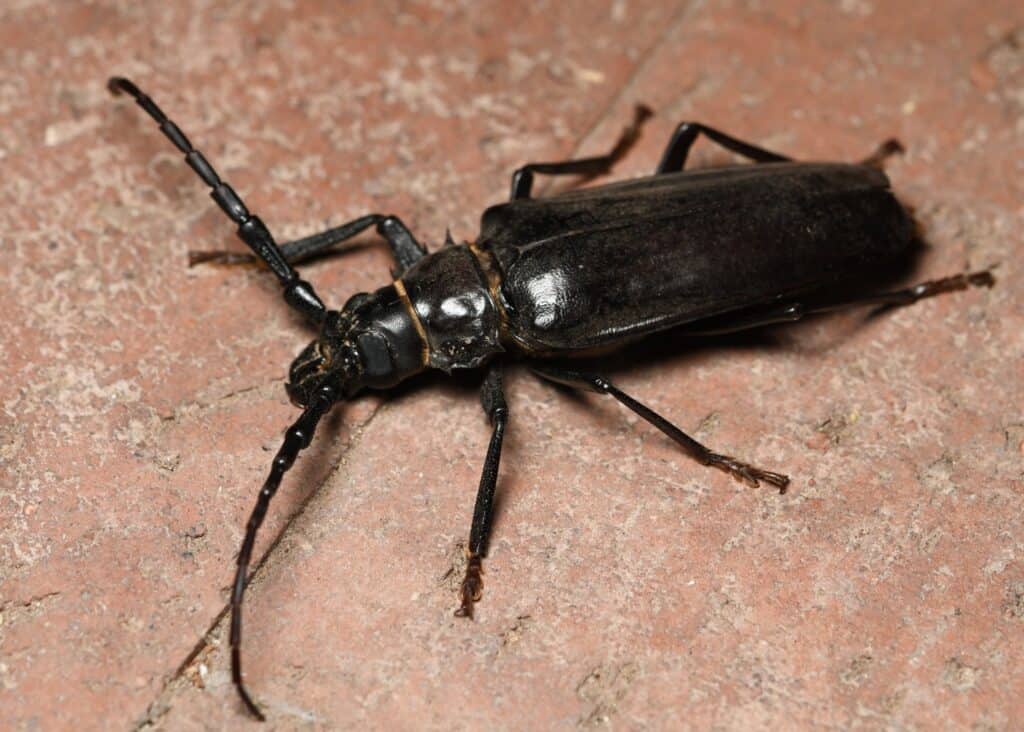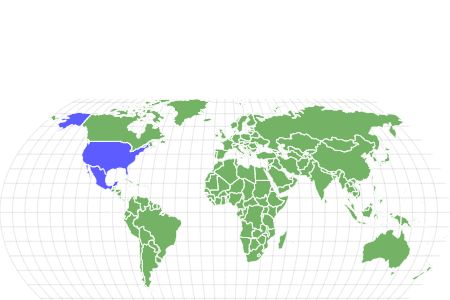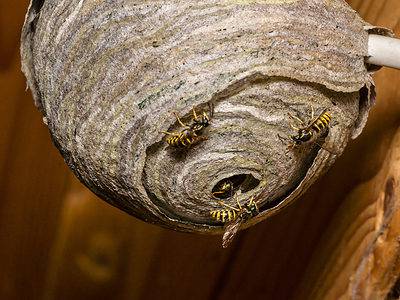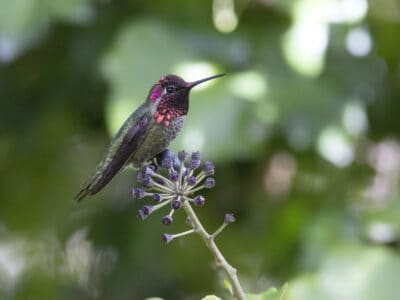Palo Verde Beetle
Derobrachus hovorei
The palo verde beetle is one of the largest beetles in North America
Advertisement
Palo Verde Beetle Scientific Classification
- Kingdom
- Animalia
- Phylum
- Arthropoda
- Class
- Insecta
- Order
- Coleoptera
- Family
- Cerambycidae
- Genus
- Derobrachus
- Scientific Name
- Derobrachus hovorei
Read our Complete Guide to Classification of Animals.
Palo Verde Beetle Conservation Status
Palo Verde Beetle Facts
- Name Of Young
- larva
- Group Behavior
- Solitary
- Fun Fact
- The palo verde beetle is one of the largest beetles in North America
- Biggest Threat
- Predation by coyotes and birds
- Most Distinctive Feature
- They have very long segmented antennae
- Other Name(s)
- Palo verde root borer and palo verde borer beetle
- Habitat
- Near host trees (palo verde tree)
- Predators
- Coyotes and birds
- Diet
- Herbivore
- Lifestyle
- Nocturnal
- Favorite Food
- Roots of the palo verde plant
- Type
- Long horn beetle
- Common Name
- Palo verde beetle
- Origin
- North America
- Location
- southwestern United States to Northern Mexico
View all of the Palo Verde Beetle images!
The palo verde beetle is one of the largest beetles in North America.
Summary
The Palo Verde Beetle (Derobrachus hovorei) is a species of wood-boring beetle that belongs to the family Cerambycidae. The beetle is native to the United States and Northern Mexico, where they’re mostly associated with the palo verde tree. The beetle is one of the largest in North America. The larval form of this beetle feeds on trees, but the adults do not feed throughout their short lifespan.
Palo Verde Beetle Species, Types, and Scientific Name
The Palo Verde beetle (Derobrachus hovorei) is known by many names, including the palo verde root borer and palo verde borer beetle. It is named after the palo verde tree, one of the largest trees in North America. The larvae of this bug feed on the roots of this tree.
Palo verde borer belongs to the beetle family Cerambycidae. Insects in this family are otherwise called Longhorn beetles or longicorns. Their name refers to their extremely long antennae, located on low tubercles on the Insect’sInsect’s face. There are more than 35,000 species of longhorn beetles.
They are native to North America. They’re predominantly found in the southwestern United States and northern Mexico. For about a century, this beetle species was wrongly identified with the beetle Derobrachus geminatus, another longhorn of the same genus, due to the similarities in their appearance. It wasn’t until 2007 that it was correctly identified and designated as a separate species.
Appearance: How to Identify Palo Verde Beetle

The palo verde beetle is one of the largest beetles in North America.
©(2,048 × 1,464 pixels, file size: 1.75 MB, MIME type: image/jpeg) – License
The palo verde beetle is one of the largest beetles in North America. Adults can reach lengths of up to 54 to 56 mm (2-4 inches). Their most distinctive feature is their long antennae. They also have small spines on their thorax.
Adult palo verde wood borers are typically black or brown. They have strong, prominent jaws but do not use this for feeding. In fact, adults don’t feed at all. They reserve their energy mainly for mating, after which they die off in about a month. Although they are not harmful to people, they can bite with their powerful jaws in self-defense.
Like many other beetles, Palo verde beetles have wings enclosed by hardened elytra. They can fly clumsily with their wings but don’t do this often. The larvae of this Insect are typically cream in color but can also be pale-green with a brown head. They bore into the roots of trees (especially the palo verde tree.).
The beetle exhibit slight sexual dimorphism. When viewed from above, the abdomen of the females extends slightly past their wing cover. That of the male is either completely hidden by the wings or barely peeking out.
Habitat: Where to Find Palo Verde Beetle
Palo verde trees are native to North America. Their range includes the southwestern United States to Northern Mexico. In places where you can find this bug, they mostly live in urban and suburban environments. However, gardeners often uncover the huge grubs while doing yard maintenance in flower beds or lawns that contain host trees.
Their most popular host plant is the palo verde tree. However, they sometimes bore into the growing roots of citrus trees, cottonweeds, Siberian elms, and mulberry plants. Adults emerge during the summer monsoon period and die off after about a month.
Diet: What do Palo Verde Beetles eat?
Adults don’t feed. They live for about a month. During this time, they survive on energy reserves accumulated during the larvae stage of development. The larvae live underground for up to 3 years feeding on plant roots. Although D. hovorei is mostly associated with the palo verde tree, adults can feed on various plants. This includes the Siberian elm, mulberry trees, and cottonwoods. In warm desert areas, they may feed on citrus plants as well. This beetle is often accused of causing tree branches to die back.
What Eats Palo Verde Beetles?
Palo verde serves as prey for large predators such as coyotes and birds. These predators can crack the tough exoskeleton of these beetles, and their large mandibles are not strong enough to harm the predators. The beetle is not harmful to humans, but they can bite in self-defense.
Prevention: How to Get Rid of Palo Verde Beetle
Although people often blame this insect’sInsect’s larvae for the death of palo verde trees and other host plants, evidence suggests that this is unlikely. The palo verde beetle and other insects in their family feed mainly on dead wood and have coexisted with palo verde trees for years. As long as trees are healthy, the beetle does not pose a threat to them. Keeping the tree roots clean and properly watering and fertilizing the trees will keep the bug from causing significant damage.
Adults tend to move towards bright light at night. If you find their presence unsettling, you can limit lights, especially around Monsoon season, to prevent them from getting attracted to your home.
Related Animals
View all 192 animals that start with PPalo Verde Beetle FAQs (Frequently Asked Questions)
Are palo verde beetles dangerous?
Palo verde beetles have large and powerful pincers. Although they can use these pincers to deliver a painful pinch, they rarely do this unless they’re agitated. They do not sting or release dangerous toxins, making them relatively safe.
How do you identify palo verde beetles?
Palo verde beetles are large imposing insects with hardened shells. They’re usually about 2-4 inches in length. They’re longhorn beetles which means they have very long antennae. They’re also characterized by short spines on their thorax.
What do palo verde beetles eat?
Adult palo verde beetles don’t feed. They live for about one month and survive on their food reserves. Their larvae feed on the roots of palo verde trees. However, they may also feed on other trees like the Siberian elm, mulberry trees, and cottonwoods.
Thank you for reading! Have some feedback for us? Contact the AZ Animals editorial team.
Sources
- Wikipedia, Available here: https://en.wikipedia.org/wiki/Derobrachus_hovor
- Abc15 Arizona, Available here: https://www.abc15.com/news/state/monsoon-bugs-things-you-need-to-know-about-palo-verde-beetles
- Sky Island Alliance / Bryon Lichtenhan, Available here: https://skyislandalliance.org/2021/02/a-microscopic-view-of-a-palo-verde-root-borer-beetle/

















